
Guests
- Jeff Orlowskiis the director of Chasing Ice. He began filming on the initial expedition of the Extreme Ice Survey. That winter, the team scouted and filmed glaciers that now appear in the documentary feature film Chasing Ice.
- James Balogis an award-winning photographer whose work revolves around the relationship between humans and nature. He is featured in the new film, Chasing Ice, which follows his work with the Extreme Ice Survey, a long-term photography project that works to preserve a visual legacy of how climate change and other human activity impacts the planet. Balog is the author of seven books, including, most recently, Ice: Portraits of Vanishing Glaciers.
A new documentary looks at how photographer James Balog captured climate change on film by placing two dozen time-lapse cameras throughout the Arctic and other areas to document melting glaciers. Dubbed by some a new “Inconvenient Truth,” the film chronicles Balog’s work with the Extreme Ice Survey, a long-term photography project that works to preserve a visual legacy of how climate change and other human activity impacts the planet. We’re joined by Balog and the film’s director, Jeff Orlowski. Balog is an award-winning photographer whose work revolves around the relationship between humans and nature. He is the author of seven books, including, most recently, “Ice: Portraits of Vanishing Glaciers.” [includes rush transcript]
Transcript
AMY GOODMAN: We continue now on the topic of global warming with a film some are calling the new Inconvenient Truth. It’s called Chasing Ice. It documents the effort of award-winning photographer James Balog and his team to gather undeniable evidence of global warming. This is an excerpt from the film’s trailer.
JAMES BALOG: It’s been shooting the entire time. Fantastic! Here’s the memory of the camera, and this is—actually, that’s an interesting thought: this is the memory of the landscape. That landscape is gone. It may never be seen again in the history of civilization, and it’s stored right here.
AMY GOODMAN: The trailer for the new film, Chasing Ice, opening in theaters nationwide this week, tomorrow in New York at Lincoln Center at the Francesca Beale Theater, as well as places all over the country.
Well, for more, we’re joined by the film’s director, Jeff Orlowski, and by its main subject, James Balog, who’s an award-winning photographer whose work revolves around the relationship between humans and nature. The film chronicles his work with the Extreme Ice Survey, a long-term photography project that works to preserve a visual legacy of how climate change and other human activity impacts the planet. He’s the author of seven books, including, most recently, Ice: Portraits of Vanishing Glaciers.
James Balog and Jeff Orlowski, thanks so much for being with us.
JAMES BALOG: Thank you. Good morning.
AMY GOODMAN: This film, Chasing Ice, is astounding. It’s chasing you chasing ice, James.
JAMES BALOG: Yes.
AMY GOODMAN: So talk about how you went about doing this project.
JAMES BALOG: Well, I’ve been fascinated by glaciers and big mountains for basically my entire adult life, since I started being a mountaineer. And that interest and life experience led me into realizing that ice was the place where you could—you could get a three-dimensional manifestation of climate change. You know, climate change is kind of abstract; a lot of it’s based on statistics and measurements and projections. But in ice, you really see climate change in action. It’s rendered in three dimensions.
So, I had an assignment from—sorry, The New Yorker, and then that led to a National Geographic assignment, and that in turn led to realizing that if we put time-lapse cameras out, we could make a running record of how the landscape was changing. So, as we sit here this morning, we have 34 time-lapse cameras at 16 glaciers in Alaska, Greenland, Iceland, Montana, in the Northern Rockies, and in Nepal by Mount Everest. And these cameras are just sitting there clicking away. And in about another, you know, 10 minutes or so, we’ll have 34 of our little robot eyes opening and closing and capturing the memory of what’s happening in those places right now.
AMY GOODMAN: Now, you initially put them in Greenland, Alaska—
JAMES BALOG: Yes.
AMY GOODMAN: —Montana?
JEFF ORLOWSKI: And Iceland.
JAMES BALOG: And Iceland, yeah.
AMY GOODMAN: And Iceland.
JAMES BALOG: Mm-hmm, mm-hmm.
AMY GOODMAN: In this clip from Chasing Ice, you describe what you’ve documented at one of the glaciers you monitor.
JAMES BALOG: 1984, the glacier was down there 11 miles away, and today it’s back here, receded 11 miles. The glacier is retreating, but it’s also thinning at the same time. It’s like air being let out of the balloon. You can see what’s called the trim line. It’s the high watermark of the glacier in 1984. That vertical change is the height of the Empire State Building.
AMY GOODMAN: That’s James Balog on film in Chasing Ice. Continue the story.
JAMES BALOG: Well, yeah, these—this glacier is called Columbia Glacier. It’s in south-central Alaska. And it’s deflating due to a combination of climate change and local glacier dynamics. But that glacier is retreated now—since that shot was taken, it’s probably pulled back close to another half-mile or a mile.
JEFF ORLOWSKI: At least.
JAMES BALOG: At least, yeah. And it continues sort of in a rapid retreat, and it will go crawling its way back up the valley. And all that ice that was once there is now part of the Pacific Ocean. It’s melted away, and it’s gone.
AMY GOODMAN: You have this amazing moment in the film, when you first come to bring the time-lapse cameras, where you’re standing there, and you actually see a glacier calving. Explain what that is.
JAMES BALOG: Yeah, calving is—well, let me describe what a glacier does. These big rivers of ice come flowing down these valleys, and when they meet a body of water, like a lake or like the ocean, they form this big wall that’s called a calving face. C-A-L-V-I-N-G. And that wall is anywhere from 200-, in a few cases maybe 400-, feet high. It’s between 200- and 400-feet high. And when a calving event happens, these massive icebergs just come toppling off the front face of the glacier, and they become these big things that are bobbing in the water, floating out to sea. What also happens, though, is that if you see 200 feet above water, there’s probably somewhere between eight and 10 times that vertical distance underneath the water. There’s a lot ice that’s under the sea surface. And all of that breaks off in these big chunks and goes floating out. It’s quite dramatic.
AMY GOODMAN: And talk about what you saw right there in that—I mean, how rare this is. You and your team were—where was it?
JEFF ORLOWSKI: At the Ilulissat Glacier.
JAMES BALOG: The one I think you’re referring to was in Greenland, yeah, the Ilulissat Glacier. And Jeff and one of our other field team, Adam LeWinter, were actually there.
AMY GOODMAN: You were there.
JEFF ORLOWSKI: Yeah, I shot that with our other friend, Adam. We knew that these calving events happened every once in a while, but we didn’t know when. And so, we scheduled a month-long trip where we would maintain a 24-hour vigil just to capture something like this. It was in May. We had 24 hours of daylight. The two of us had eight-hour shifts, and we kept—somebody was awake every single minute of every single day for that entire period. And we were just waiting for something big like that to happen. What we caught, it turns out it’s the largest calving event that’s ever been documented, that’s ever been shot like that. And that’s one of the featured scenes in the film.
AMY GOODMAN: So you have this, where you’re going out, and then you have the politics of how people are dealing with climate change. For example, just yesterday, President Obama, in his first news conference since he has been re-elected—
JEFF ORLOWSKI: Right.
AMY GOODMAN: —did actually address the issue of global warming, because he was asked about it. This is an excerpt when he refers to the Arctic.
JEFF ORLOWSKI: Yeah.
PRESIDENT BARACK OBAMA: What we do know is the temperature around the globe is increasing faster than was predicted even 10 years ago. We do know that the Arctic ice cap is melting faster than was predicted even five years ago.
AMY GOODMAN: And in his news conference, President Obama acknowledged his administration, quote, “[hasn’t] done as much,” he said, “as we need to.”
PRESIDENT BARACK OBAMA: We haven’t done as much as we need to. So, what I’m going to be doing over the next several weeks, next several months, is having a conversation, a wide-ranging conversation with scientists, engineers and elected officials, to find out what can—what more can we do to make short-term progress in reducing carbons, and then working through an education process that I think is necessary, a discussion, a conversation across the country about what realistically can we do long term to make sure that this is not something we’re passing on to future generations that is going to be very expensive and very painful to deal with.
AMY GOODMAN: Jeff Orlowski, in your film, Chasing Ice, you open with the climate change deniers, people like, oh, Sean Hannity of Fox, who says, “You know the left. If it gets hot out, they say it’s global warming. If it gets cold out, they say it’s global warming.” How do you go from the Arctic back here and hear this?
JEFF ORLOWSKI: Yeah, it’s very interesting having that real boots-on-the-ground experience and seeing how the planet is changing, and then seeing the political commentary around it. You know, the president is in a tough position, and a lot of the politicians are, because they hear two sides of the story. I mean, we’re hearing the science and the scientists and kind of—you know, it’s very unanimous: 97 percent of the climate experts all agree that it’s happening, it’s man-made, we need to do something about it. But in Washington, they’ve got six lobbyists from the fossil fuel industry, at least, for every member of the Senate and the House. So they’re hearing a very, very different skewed story on the reality of the situation. What we were trying to do was to capture evidence, to capture imagery, that takes it away from this bipartisan debate and tries to move the conversation forward.
AMY GOODMAN: And you come back here, Jeff Orlowski, to New York, where we were just hit with Superstorm Sandy.
JEFF ORLOWSKI: Yeah.
AMY GOODMAN: And your grandmother’s house in Staten Island—
JEFF ORLOWSKI: Yeah.
AMY GOODMAN: —where you grew up—
JEFF ORLOWSKI: Yeah.
AMY GOODMAN: —hard hit. That’s where President Obama is going today, is Staten Island.
JEFF ORLOWSKI: Right, right, I heard. It’s something where—people kept asking us, “What are the consequences of climate change? So what? Why does it matter if the ice melts? It’s in Greenland, and it’s thousands of miles away.” And we were trying to relate that to people. The scientists have been telling us for decades that because of warming temperatures, because of melting ice, events like Sandy are going to happen with greater frequency, or they’re going to get more violent. And that’s really the end result. That’s what climate change represents, is more events like Sandy.
AMY GOODMAN: James, you didn’t particularly believe in climate change decades ago?
JAMES BALOG: Yeah, I thought it was based on computer models, and I really didn’t have it in my psyche that it was possible for humans to change the basic physics and chemistry of this gigantic planet. It just didn’t seem probable.
AMY GOODMAN: Your work is so massive, so epic—and we just have a minute ago. Talk about how chasing ice, your actually chasing ice, has changed you.
JAMES BALOG: Yeah, I’ve—I’ve been profoundly reshaped in my own mind, in my own mentality and life experience, by this. I am really, really, really concerned for my daughters’ future. I have a 24-year-old daughter, and I have an 11-year-old daughter. And I’m quite concerned that the—that by the time they get to be our age, they’re going to be living in a world that’s so radically different from what we’re living in, and it might be not such a great world. I think they’re certain to be living in much more violent extremes of weather, with unknowable geopolitical consequences from that, from perhaps agriculture stress, drought stress, whatever. I’m very concerned about the stability and security and safety of the world that my kids will be in.
AMY GOODMAN: I want to thank you both for being with us and for making Chasing Ice and for your life work, James.
JAMES BALOG: Thank you.
AMY GOODMAN: James Balog, award-winning photographer whose work revolves around the relationship between humans and nature. He is featured in the new film, Chasing Ice, which follows his work with the Extreme Ice Survey, a long-term photography project that works to preserve a visual legacy of how climate change and other human activity impacts the planet. Balog is the author of seven books, his latest called Ice: Portraits of Vanishing Glaciers.

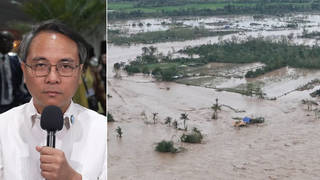
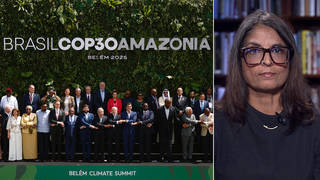
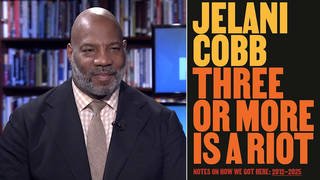
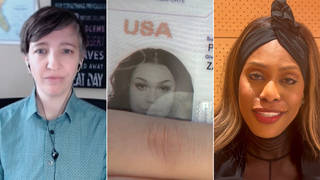





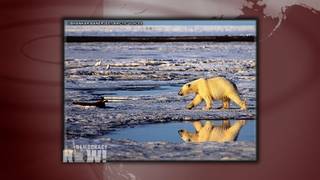
Media Options